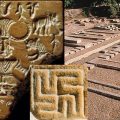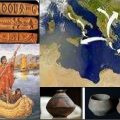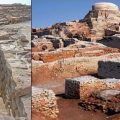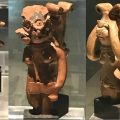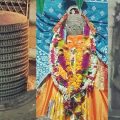Tilottama: A Connection between the Indus Valley Civilization and Mahabharata
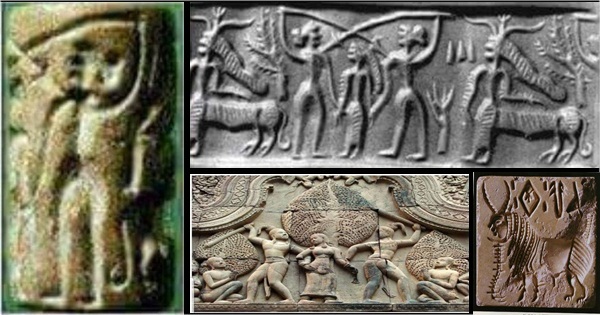
Evidence that the ancient Indus Valley Civilization and certain stories from the Mahabharata are related.
The following lengthy conversation by our Indus Valley Culture research group was brought about by quite a remarkable discovery that Pradipta Banerjee made a few years back.
Make sure to have a look at the picture of the IVC seal and the Cambodian frieze first.
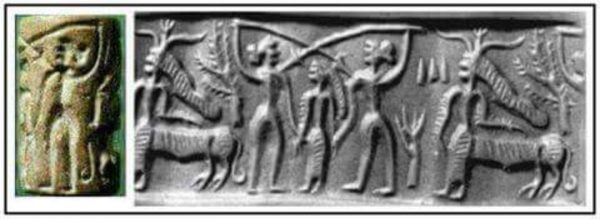
The picture of the cylinder seal itself is via Mr. Kalyanaraman
Here is a story from the Mahabharata, Book 1: Adi Parva: Rajya-labha Parva: Section CCXIV:
“Meanwhile Tilottama attired in a single piece of red silk that exposed all her charms, came along, plucking wild flowers on her way.
She advanced slowly to where those mighty Asuras were. The Asura brothers, intoxicated with the large portions they had imbibed, were smitten upon beholding that maiden of transcendent beauty.
Leaving their seats they went quickly to where the damsel was. Both of them being under the influence of lust, each sought the maiden for himself. And Sunda seized that maid of fair brows by her right hand.
Intoxicated with the boons they had obtained, with physical might, with the wealth and gems they had gathered from every quarter, and with the wine they had drunk, maddened with all these, and influenced by wishful desire, they addressed each other, each contracting his bow in anger,
‘She is my wife, and therefore your superior,’ said Sunda.
‘She is my wife, and therefore your sister-in-law’, replied Upasunda. And they said unto each other,
‘She is mine not yours.’
And soon they were under the influence of rage. Maddened by the beauty of the damsel, they soon forgot their love and affection for each other. Both of them, deprived of reason by passion, then took up their fierce maces.
Each repeating, ‘I was the first’, ‘I was the first,’ (in taking her hand) struck the other.
And the fierce Asuras, struck by each other with the mace, fell down upon the ground, their bodies bathed in blood, like two suns dislodged from the firmament.”
This is an example of quite a few links between a number of narrative Indus Valley seals and a variety of legends and myths that was found in the Mahabharata, the Ramayana, the Vedas and the Puranas by a small team of researchers. (Their extensive effort to report these links has been going on since 15 August 2011 – an auspicious day.)
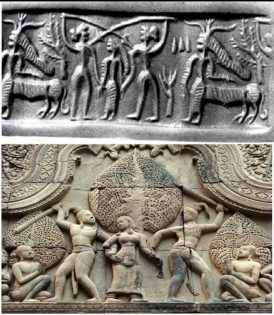
DISCUSSION
Sue Sullivan: Nice find Pradipta, the discovery of the cylinder seal’s meaning. I think we’ve got Vishnu as Narasimha looking on, because the cylinder seal inscription says, from the top down, ‘ja-rya,’ (Noble Vishnu).
Pradipta Banerjee: Could be, after all, all these demon killing policies come from his head. 
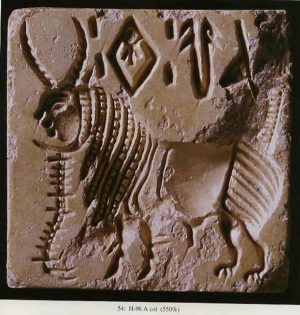
Wim Borsboom: That the shorter figure in the middle on the cylinder seal’s offprint is skirted, is a rare depiction… definitely female.
Nilesh Nilkanth Oak: Sue, I don’t know if you noticed, but there is another ‘rya’ on the left area (side) of the seal.!!! Notice the similarity between ‘rya’ (in the middle, i.e. on below ‘Ja’) and two tree likes structures (one on the left and one of the right) above the back of lion-like entities.
Wim Borsboom: Could “rya” be part of “aryan”, or is that too much of a stretch?
Nilesh Nilkanth Oak: My Cupiditas Speculandi on Vishnu. Sunda-Upasunda (with Tila-Uttama) motif is a common motif and is understood by some (Stephen Oppenheimer’s book lists many other myths on similar lines. Two brothers may change to two friends, two kings etc.). This motif is understood as separation of two cultures (due to natural calamity), the lady in the middle representing the civilization. In this motif, usually one or both of the fighters get destroyed. If you consider ‘Nurturing’ role of Vishnu (Brahma-creation, Shiva -dissolution) then death of one or both fighters may symbolize destruction (seed) in order to have growth (crop). The middle female symbol (Tila-Uttma. excellent sesame, or seeds) is a well know agriculture symbol.
Wim, regarding your “rya” being a part of Aryan, that may not be a stretch if you consider Sunda or Upasunda, before “rya” is “Aa” per Sullivan Code!
Wim Borsboom: Hmm…, Nilesh, about the symbolic interpretations that you mention… I understand why and how symbolic interpretations happen and can be useful, they might serve an important purpose, but my experience with interpreting commentators is that they tend to go too quickly for the symbolic when they do not understand or cannot acknowledge the original meaning of the things they attribute symbolic meanings to.
When I decided (on a hunch) that the narrative seals must have had to do with simple (perhaps heroic) stories or even folk-tales, and that I initially should not read any symbolic messages into them, it became easy to find the origins of those narratives. (And… look at it, this cylinder seal proves that point.)
It is possible that they were also used for moral or spiritual purposes, and that is wonderful, and it may have been effective, but I tend to first go for the simple…, the self-evident and realistic…
IVC people were, I think, in the first place pragmatic.
Sue Sullivan: Since the lady’s name Tilottama means “excellent sesame”, and the two men are seemingly threshing away, I see this tale as a metaphor for a well-known agricultural process that separates seed from stems, like as though those two men are threshing rye…. hence perhaps “rya”?
Wim, yes, the ‘rya’ sign is used to spell ‘arya.’Some examples are seal Lothal L-2a (aryantamashiekade), seal M-71a (aryaviartayama), and seal M-708 (aryavitan).
Pradipta Banerjee: Nilesh, you are correct in saying that “tila” means sesame. However, the tila here most probably doesn’t refer to any crop. It means “small”, “tiny”… (Hmm… It could even be a tilak!.)
The story gives details as to why her name is Tilottama. When Vishvakrma started creating her, he took the smallest unit (a tila) of all the beautiful things in the 3 worlds and joined these small units to make a composite girl so that even the smallest part (a tila) of her was exceedingly beautiful. In Bengali as well as Sanskrit the words “by the tila” means very minute details.
Of course, they could have deliberately used this very word as a pun on both “agriculture” and “minute details”. It is something the authors of Rig and Atharva Veda do all the time.
Also, I agree to your point it may have had something to do with separation… maybe one half to the Sumer and the other half to western Gangetic plains.
Wim Borsboom: Pradipta, you are right about that seal: K65, I even found a picture of just the cylinder. I first thought that it came from Mesopotamia, but Kalibangan is better.
I read somewhere: “In Hindu legends and beliefs, tales are told in which sesame seeds represent a symbol of immortality and the God Maha Vishnu’s consort Maha Sri Devi herself representing the properties of the sesame seed, as such it is considered as the most auspicious oil next to ghee used in Hindu rituals and prayers.”
In 4,000 BCE, Indus Valley agriculture was very extensive: wheat, peas, sesame seed, barley, dates, mangoes.
Apoorva Bhandari: So, where exactly is that 2nd sculpture from? What period is it from and how do we know its linked to this story?
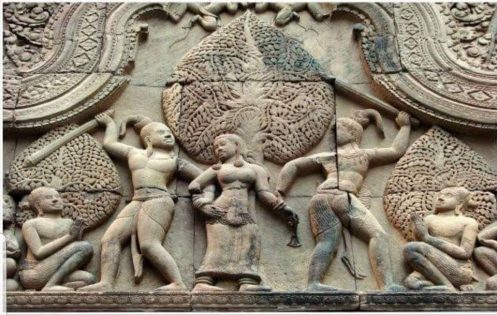
Pradipta Banerjee: The second sculpture is from a Khmer dynasty Hindu temple from Cambodia. Built during 11-14th century AD. There are Sunda-Upasunda figures in Indian temples also, but I couldn’t find a high-resolution picture on the net.
Nilesh Nilkanth Oak: “Ja” in ‘ja-rya’ caught my curiosity, so I was checking a few words. What I had in mind (hypothesis) was to see if ‘Ja’ referred to Vishnu in female form (likes of Tilottama, Mohini, etc.), I did not find exactly what I was looking for. But here is something worth mentioning anyways… ‘Jadyni – Jajni’ with ‘jna’ of ‘Prati-jna’ means Queeen. I knew ‘Ra-dyni, Ra-jni’ did mean Queen and also ‘RaNi’ in our times. Does that mean Ja might interchange with ‘Ra’ and that ‘jna, dyna’ may interchange with ‘NA’?
Something to keep in mind as we attempt to decipher IVC Script using Sullivan Code.
Wim Borsboom: Apoorva Bhandari, yes, that relief is from Ankor Wat, in Cambodia, from between the reign of Jayavarman II (802-850 CE) to that of Jayavarman VII (1181-1219 CE).
Khmer (Cambodian) Buddhism was a synthesis of Hinduism and Buddhism… Indra, Vishnu, Shiva, Krishna, Ganesha even Hanuman appear in the reliefs.
Nilesh, phonetically the dental and alveolar consonants r, d, n, j, dj, nj, jn are all formed in the front of the mouth with the tongue touching the inside of the upper teeth, so phonemic interchange occurs easily.
Pradipta Banerjee: Yes, Wim, Cambodia or Kambuja-desh, as we called it, along with Myanmar and Malaysia has a Hindu past. When Buddhism caught on, I think they upgraded to a synthesis of both religions; accepting Buddha as an avatar of Vishnu and praising both. Much like how we did here. (Imagine how horrified Buddha would be at that!!!! :-0) Their monumental temples stand as the pinnacle of sculpture, science and religion.
All of their sculptures depict stories from the Puranas; along with Apsaras, vanaras and gandharvas.
Nilesh Nilkanth Oak: Wim, thanks for your short course on ‘velars ‘. In general, I am an extremely poor student of linguistics, grammar and languages. In recent (or not so recent depending on definition) Indian ‘Sadee’ (long piece of cloth Indian women wear became ‘Saree’ in the west. That is from ‘d’ to ‘r’. One illustration of above rule.
Wim Borsboom: Nilesh, I went into phonetics quite intensively when studying to become a teacher when I still lived in Holland (of course we used Dutch language definitions) but since then a lot more phonetic research has been done – I couldn’t even keep up anymore – but my rudimentary knowledge still serves me well.
Nilesh Nilkanth Oak: So sad too many academic chairs are hanging on to their own creation -jargon- of linguistics. Many of them don’t bother to explain these linguistic terms. If they are writing books, they better explain them, else should stick to publishing in their ‘mutual admiration club’ journal where only they write and they read. Koenraad Elst is one I could read and understand somewhat! Edwin Bryant was ok too. With Michael Witzel, it’s a double whammy… he wants to show off his knowledge of linguistics (which I presume he is good at.. I have no way of knowing) but also draws foolish conclusions which HE has no way of knowing!
Wim Borsboom: Pradipta, you said, “Imagine how horrified Buddha would be at that!!!! :-0)”
Buddha was the purist of the following lineage of avatars: Vishnu, Rama, Krishna, Buddha, Christ… I feel like putting Skanda in between Rama and Krishna.
Each divine/human being in the following list focused on specific qualities and characteristics of moksha – liberation:
• Vishnu focused on the acceptance of physical existence and keeping it in good order,
• Rama, the perfect and most virtuous human,
• Skanda making sure liberation remained accessible for the common human being,
• Krishna who combined both playful, meditational and martial aspects of being yourself and standing up for yourself,
• Buddha for purifying, simplifying and setting up a system (the Triple Gem, the Eightfold path) to follow methodically.
• Christ to make sure we never forget that unconditional love, compassion and sacrifice are part of personal freedom and helping others to become free.
Please, feel free to tell me what characteristics I should add to the list above, I may have overlooked someone in that lineage… female gods for instance!
What is so great about Indian culture and spirituality, the feminine gets acknowledged much more often than other cultures tend to do: Sarasvati, Parvati, Lakshmi are at least equivalent to their male partners… Please tell me where to insert them in my list above, and what they are standing for!
Pradipta Banerjee: Wim, regarding your question on the feminine in Indian mythology; two short stories:
1. A legend from Karnataka:
Vishnu after killing Narkasur boasts about it to Lakshmi, who reminds her that his power stems from her. An angered Vishnu is about to tell her rude words but sees he can’t move a muscle. He apologizes immediately.
2. From Bengal and Orissa:
Sati wants to visit her father Daksha, who is performing a famous yagna. Shiva, her husband forbids her from doing so, all in her best intentions. She persists, and Shiva gets angry and is about show his rudra-roop (furious form) when Sati becomes 10 terrible Goddesses and attacks him from 10 different directions. A frightened and surprised Shiva asks for Sati to calm down and to do as she pleases.
There are countless such stories in our culture and they all depict one thing: Male/Purusha is mass/matter/Jada while Feminine/Viraj/prakriti is energy/Shakti. Only the true union of mass and energy can produce life; and that is why the shiva linga has both phallus (the pillar) and yoni (the base), that is why the male Gods are worshiped, they are “mass”; they have a form, they kill asuras, act as teachers to humanity while the feminine lies within them, unseen, chaotic, uncontrollable as their source of inspiration, creativeness and energy. None can exist without the other.
Ahum!!!! 
Nilesh Nilkanth Oak: Pradipta, the holistic message of Indian philosophy (specifically with aspect of Prakriti and Purush – feminine and manly principle) is: While Man makes the history, Woman IS the history.
Pradipta Banerjee: Nilesh, I thought it would be “Man makes history, while woman remains a mystery”!
Nilesh Nilkanth Oak: Pradipta, that too. Once in a while though She reveals a ‘Tila’ amount of her ever-mysterious aspect and then we have ‘Tila’; look at the truth such as that of “Mystery of Arundhati”.
Wim Borsboom: Ah, if only those at times angry gods and feisty goddesses could see that it is possible to not be bipolar.. Ehh… to not polarize their behaviors so extremely… They could learn something from our conversation here! Luckily, many in our current world are working towards gentleness… but it is a lot of work to undo the karmic behaviors that some demons AND gods left us with…
Ali Raza: Let me interject to get back on track.
Definitely, this seal represents some important incident, and the only way to understand it, is to take help from regional mythology. The reference of deity sitting under tree definitely resemblance from puranas stories and above-mentioned picture have much resemblance. If you visit the old cities which left destroyed, burned, but their holy places still exist, many converted according to new religion of local people, same time their stories still exist in the heart of people. More interesting thing is that, the stories of ancient gods also survives which attached to Karramat of baba jee, whom tomb constructed on the same place where ancient holy building once existed, for example Lal shabiz Qalander. If you can’t believe this, please visit some ancient mounds you found, tomb, shrine mosque temple or shrine.
Jeyakumar Ramasami: Dear P. Bannerjee, I saw your comments today. I am sorry, I didn’t know, wherefrom this idea emanated on “Tilottama” —- What is the date of publishing your idea? Because this same idea has been published by Shri Iravatham Mahadevan already.
Is the posting date Nov 3, 2011?
But, the same idea has already been published by Shri. Mahadevan on August , 2011—printed bulletin form —-
If you want to claim authorship to this idea, it should be much before the date of publication by Shri. I.Mahadevan. Kindly give some more details, I would like to present those facts in my website.
If it is your original idea, then you should get a lot of appreciation…: you have correctly identified and compared the Indus seal scene with an existing Mahabharata story.
Wim Borsboom: Jeyakumar Ramasami, I believe that the comparison of the IVC seal and the Cambodian Tilottama relief (in Musée Guimet, Paris) was originally done by Pradipta Banerjee, who, as far as I know, when he suggested MB’s Tilottama connection, was not aware of Mahadevan’s paper. (By the way, over the last half a year I have been relating about twelve IVC seals to stories and legends from the Rig Veda, Mahabharata, Puranas and Ramayana.)
Mahadevan did indeed correctly draw the connection between the cylinder seal and the MB story. However, Mahadevan’s comparison on page 44 of his paper between this cylinder seal and the seal with the two men holding two uprooted trees is not correct, as, in my opinion, that seal narrates an episode from Krishna’s youthful exploits… (I have already prepared a publication on that, but am collecting more evidence to make it iron-clad, it has to do with Krishna’s uprooting of the two Arjuna trees which freed Kuvera’s two immoral sons (Nalakuvara and Manigriva) who were cursed by Narada to became trees until Krishna set them free.
Jeyakumar Ramasami: Thank you, sir, for your clarification.
Pradipta Banerjee; Mr. Ramasami, as Wim correctly guessed, I wasn’t aware of Mahadevan’s paper until it was posted on December 23rd. Anyway, thank you for your response. Our little group here, spearheaded mostly by Wim, has tentatively made some other connections of contemporary Indian myths and the seals (much like your work on the tiger/hunter story). Thank you for the appreciation.
Sue Sullivan: Jeyakumar, many thanks for pointing out that Mahadevan mentioned the Tilottama/K-65 connection in his paper of August 2011. I have edited my book to include this data.
Wim Borsboom: Jeyakumar, on January 2 (two days ago), when I went through the photo section of the Harappa Facebook page, I clicked on a portrait photo which at that time I did not know was you…
I kept following the links and eventually saw a very interesting book which I downloaded for later reading…
Then yesterday I saw the comment on the above picture and suddenly it dawned on me that the portrait picture I clicked on the day before was you. Then Pradipta in his comment above mentioned your work, so I quickly accessed your book and what a wonderful surprise… even if our conclusions don’t match, we do appear to share the same intuition at times…
In addition, I saw on your web-site (not in your book) that you noted that the Indus Script sign that is formed by a U with an ! inside and the tilak sign look alike… the same conclusion I drew a while ago…
I love coincidences like that, because if it weren’t for these kind of fortuitous coincidences, I would not have been able to interpret the seals and tablets the way I did. In CHAPTER ELEVEN of my study “Skanda – an Ancient God Rediscovered” I write about “The Tilak and the Most Frequent Indus Script Sign”.
Jeyakumar Ramasami: Dear Wim, thank you very much for your positive comments. Your ideas of connection between Indus seal depictions and Hindu mythology are correct. Your discussion on this web page is also interesting and enlightening. Kindly keep up this tempo.
Dear Pradipta, I have corrected my web page and given credit to you. But, this information is yet to be corrected in other two places, my blog site and another web site. I will correct it in due course of time. Kindly keep up your studies on Indus seals, it is quite informative.
I have given some additional observations on this Tilottama seal on my website.
Abhitosh Tripathi; In addition to the female figure and the two warring male figures, what is the interpretation for thar “Half Human Half Tiger figure”?
Sue Sullivan: The human/feline figure may be Narasimha, Vishnu’s avatar.
Shantanu P. Eksambekar: Coincidentally I was reading the story of Shunda and Upasunda this morning.
Jayendra Upadhye: “Sundopasundi” is the word…for fratricidal war! This may be correct.
Abhitosh Tripathi: Sue, Wim, in the Tilottama story there is no mention of the tiger or ram. Which made me think about their relevance. The setting of Sunda-Upsunda-Tillottama story is in Central India and at a Tabletop Mountain of Windhya Range, which is (even now largely) a heavily forested and tribal area. So I feel less partial to Narsimha or Ram interpretation. The figure appearing as half human half animal seems to be a female figure and both from bearing and headgear has something regal about it. Also from the position of the hand, it can be depicting two entities: one female making a restraining or placating gesture to an animal (we decide which later) by her side.
Notice the difference in the way the animal’s feet are depicted as compared to the female figure’s feet.
Also, what do three conical marks between the figures on the right of the central female figure mean, specifically in the context of the seal. By the way is the central figure wearing bangles?
I also think this is Sunda-Upsunda-Tillottama Story (there seems to be a common agreement here too, more or less) and not Shumbha-Nishumbha-Durga (Mother Goddess) from body language of the figures.
Wim Borsboom: Abhitosh, it is important to keep in mind:
1. This is an off-print of a cylinder-seal, so the trees and the composite creature only appear once on the cylinder itself, or as many times as one keeps rolling/pressing the cylinder in a mouldable material. So, the trees, the figure, and what you call the “three conical marks” do not necessarily surround the two men feuding over a woman…
2. That the composite creature appears on this cylinder seal, does not necessarily mean that it is connected to the theme or Indus script of the seal. It is quite normal for certain animals, composite animals or composite creatures to appear on seals of which the main theme / script has no direct link to other parts on the seal.
The three conical marks plus the tree-like mark below it, say, according to Sue Sullivan: ‘ja-rya’ which could mean “Noble Vishnu”, or contain the meaning of “jAra, lover”.
If the tree-like ‘thing’ below the three stripes is not a language sign, then the three stripes just say “Ja” which could – instead of for Vishnu – stand for “Shiva”… notice the Bilva/Bael tree near which this man-tiger is standing.
Disclaimer: The views expressed here are solely of the author. My India My Glory does not assume any responsibility for the validity or information shared in this article by the author.

